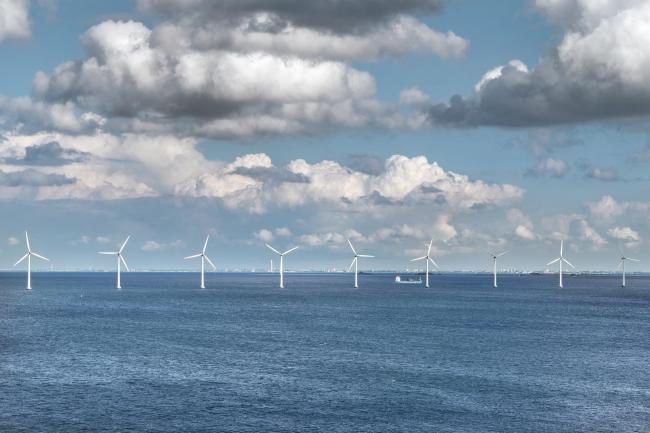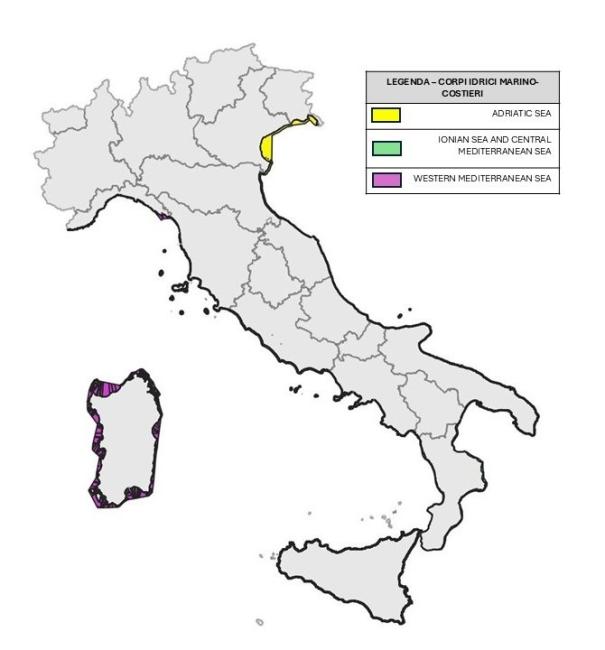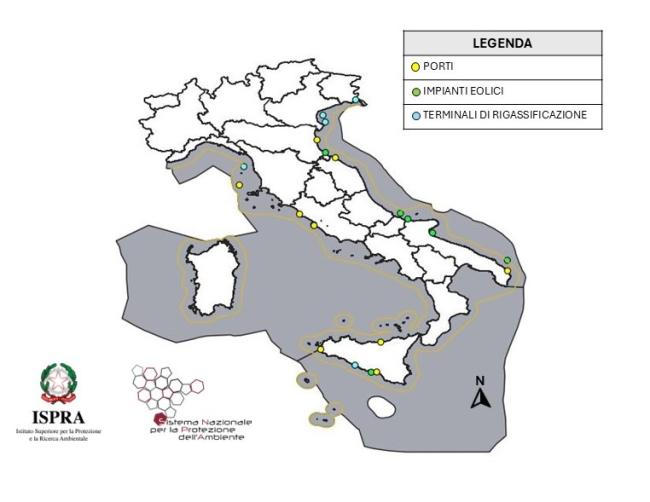Panel 1
Francesca Catini
The monitoring provided by the Marine Strategy Framework Directive 2008/56/EC for Descriptor 7 considers the permanent alterations of hydrographic conditions due to coastal and marine infrastructures subject to national EIA, constructed or under construction or design since 2012. The reference indicator for D7C1 relates to the extent of coastal marine water bodies in each marine subregion, defined under Directive 2000/60/EC, which presents impacts due to permanent changes in hydrographic conditions due to new infrastructures constructed since 2012 and subject to national EIA. The objective for this indicator is not to exceed 5% of the extent of coastal marine water bodies. In 2023, the objective was achieved.
Within Descriptor 7, the term hydrographic conditions includes both the scope of hydrological processes related to the water column such as currents, bottom energy, salinity and thermal regime, and the physiographic characteristics of the seabed in terms of morphology and substrate nature. The new Decision (EU) 2017/848 of 17 May 2017 defines the following criteria for the assessment of Good Environmental Status (GES): 1) D7C1 - Secondary: Extent, in square kilometers (km²), of the assessment area that has undergone negative hydrographic effects; 2) D7C2 - Secondary: Extent of each type of habitat that has undergone negative effects, in square kilometers (km²) or as a percentage (%) of the total extent of the natural habitat in the assessment area. This assessment was necessary because some hydrographic alterations can lead to the degradation of habitats of ecological and/or conservation interest (e.g., Posidonia oceanica meadows) or to the establishment of conditions favorable to algal blooms (including toxic ones), the spread of jellyfish, or other alterations of microbiological conditions. During the first cycle of implementation of the MSFD (2012-2018), the community working group, whose contribution is summarized in the JRC technical guidance - Technical guidance on monitoring for the Marine Strategy Framework Directive - Report EUR 26499 EN, indicated a period of 10 years beyond which a hydrographic alteration is considered permanent. Therefore, works whose construction involves a hydrographic alteration lasting less than 10 years are excluded from the impact analysis for Descriptor 7. Furthermore, in assessing the significance level of the alteration, the analysis was restricted to coastal and marine infrastructures subject to a national Environmental Impact Assessment procedure. This allowed excluding all coastal defense works, construction of small ports or marinas, and extensions of existing port infrastructures that, not subject to national EIA, are not considered to produce significant impacts on marine ecosystems as a specific consequence of hydrographic condition alterations.
To assess the impact produced by marine and coastal-marine infrastructures on habitats, both of the seabed and the water column, specifically following the modification of hydrographic conditions induced by the infrastructure itself.
- Marine Strategy Framework Directive 2008/56/EC
- Legislative Decree 190/2010 transposing the Marine Strategy Framework Directive 2008/56/EC
- Decision (EU) 2017/848
- Ministerial Decree 2 February 2021 (which adopted the "Methodological guide for monitoring infrastructures subject to national EIA and potentially capable of significantly and permanently altering hydrographic conditions and physiographic characteristics").
- Objective of the indicator set by Ministerial Decree 15 February 2019 - Good Environmental Status (GES) - G 7.1: no more than 5% of the extent of coastal marine water bodies in each marine subregion, defined under Directive 2000/60/EC, presents impacts due to permanent changes in hydrographic conditions due to new infrastructures constructed since 2012 and subject to national EIA.
Panel 2
González D., Coughlan C., Stips A., Stolk A., González Pola C., Moreno Aranda I.M., Giorgi G., Rees J., Babbini L., Manca Zeichen M., Alenius P., Cariou V., Zervakis V., Krzyminski. W. (2015) - Review of the Commission Decision 2010/477/EU concerning MSFD criteria for assessing Good Environmental Status, Descriptor 7; EUR 27544 EN; https://doi.org/10.2788/435059
Zampoukas N.; Palialexis A.; Duffek A.; Graveland J.; Giorgi G.; Hagebro C.; Hanke G.; Korpinen S.; Tasker M.; Tornero Alvarez M.; Abaza V.; Battaglia P.; Caparis M.; Dekeling R.; Frias Vega M.; Haarich M.; Katsanevakis Stylianos M.; Klein H.; Krzyminski W.; Laamanen M.; Le Gac J.; Leppanen J.; Lips U.; Maes T.; Magaletti E.; Malcolm S.; Marques J. M.; Mihail O.; Moxon R.; O'Brien C.; Panagiotidis P.; Penna M.; Piroddi C.; Probst W. N.; Raicevich S.; Trabucco B.; Tunesi L.; Van Der Graaf S.; Weiss A.; Wernersson A.; Zevenboom W. (2014) - Technical guidance on monitoring for Marine Strategy Framework Directive, JRC, Report EUR 26499 EN http://publications.jrc.ec.europa.eu/repository/handle/JRC88073 https://doi:10.2788/70344
The assessment used only criterion D7C1 on the extent, in square kilometers (km²), of the assessment area that has undergone negative hydrographic effects and not D7C2 on the extent of each type of habitat that has undergone negative effects, in square kilometers (km²) or as a percentage (%) of the total extent of the natural habitat in the assessment area.
In order to standardize the monitoring of new infrastructures subject to national EIA and relevant for the evaluation of Descriptor 7 of the Framework Directive on Marine Strategy, the “Methodological Guide for the monitoring of infrastructures subject to national EIA and potentially able to significantly and permanently alter the hydrological conditions and physiographic characteristics” was adopted with the DM 2 February 2021 “Updating of coordinated monitoring programs for the continuous assessment of the marine state of the environment”. So, unlike what has happened so far, with the adoption of this methodological guide, the proposing subjects will have to follow specific monitoring plans for the evaluation of the Descriptor 7. The annual update of the list of infrastructures subject to national EIA that will be monitored for the purposes of Descriptor 7 is planned.
Data quality assessment
ISPRA, Ministry of Environment and Energy Security (MASE)
The results on the value of the indicator are available on a six-year basis on the MSFD Report pursuant to articles 8 (marine environment evaluation) of the Framework Directive on Marine Strategy – 2008/56/EC, whose latest version -Report MSFD 2024 - is accessible through the SIC - Centralized Information System of Marine Strategy - http://www.db-strategiamarina.isprambiente.it. The monitoring data used to enhance the indicator are always accessible via the SIC in the "MSFD Report 2024" section and in the section "ARPA-ISPRA monitoring data 2018-2023".
National
2012-2023
Indicator assessment
The extent of coastal marine water bodies in each marine subregion affected by impacts caused by permanent changes in hydrographic conditions, resulting from new infrastructures constructed since 2012 and subject to national Environmental Impact Assessment (EIA), is calculated according to the following procedure: annually, a survey of coastal and marine infrastructures, constructed or under construction or design since 2012, that are subject to national EIA is conducted. For each infrastructure, the extent in square kilometers (km²) of the area that presents alterations in hydrographic conditions induced by the infrastructure itself is estimated. Subsequently, for each subregion, the extents related to the present and evaluated infrastructures are summed. Finally, the ratio between the sum of these extents and the total extent of coastal marine water bodies in the subregion is calculated.
During the first cycle of the MSFD (2012-2018), the "Methodological guide for monitoring infrastructures subject to national EIA and potentially capable of significantly and permanently altering hydrographic conditions and physiographic characteristics" was produced, adopted with the Ministerial Decree of 2 February 2021 "Update of coordinated monitoring programs for the continuous assessment of the environmental status of marine waters" to standardize the process of estimating the spatial extent of permanent changes to hydrographic conditions (D7C1) aimed at verifying the achievement of the reference target T 7.1.
However, at present, the monitoring carried out by the proponents of the 22 identified infrastructures, available on the MASE portal dedicated to EIAs (https://va.mite.gov.it/it-IT/Procedure/ProcedureInCorso), does not strictly follow the prescribed guide. The various proponents have conducted hydrographic condition monitoring and used numerical modeling for the study of wave motion and currents in a heterogeneous manner, which has not allowed for the standardization of the evaluation method. For these reasons, the spatial extent of areas affected by permanent changes in hydrographic conditions was assessed through the adoption of a criterion that allowed proceeding systematically. This criterion, regarding port infrastructures, derives from the results of the evaluation conducted on the port of Fiumicino within the EcAp-ICZM project, funded by MATTM, which is detailed in the paragraph "Evaluation conducted on the port of Fiumicino within the EcAp-ICZM project". For other types, the criterion was established through the analysis of technical documentation included in the Environmental Impact Assessment (EIA) or EIA Screening processes, as well as through consultation of relevant scientific literature.
Therefore, the extent was evaluated based on the following criteria, depending on the type of infrastructure:
- For ports, an area subject to permanent changes in hydrographic conditions equal to twice the area occupied by the infrastructure itself was considered.
- For regasification terminals, an incidence of 1 km² per infrastructure was considered.
- For wind farms, an incidence equal to 0.1 times the number of wind turbines present was considered.
The indicator value was calculated as the ratio between the sum of areas affected by permanent changes in hydrographic conditions in each marine subregion and the total extent of coastal marine water bodies in each subregion, as defined by Directive 2000/60/EC (Figure 1).
In 2023, all marine subregions (Adriatic Sea, Western Mediterranean Sea, Ionian Sea, and Central Mediterranean Sea) achieved the objective set by the Ministerial Decree of 15 February 2019 for Good Environmental Status (GES) (G 7.1), that is, no more than 5% of the extent of coastal marine water bodies in each of them presents impacts due to permanent changes in hydrographic conditions caused by new infrastructures constructed since 2012 and subject to national EIA (Table 1). Specifically, the extent of such impacts for each subregion is as follows: Western Mediterranean Sea 0.0930%, Ionian Sea and Central Mediterranean Sea 0.033%, Adriatic Sea: 1.4193% (Table 1).
As of 2023, based on the definition of GES (Good Environmental Status) for Descriptor 7 of the MSFD, there are 22 marine-coastal infrastructures constructed or under design since 2012 and subject to national EIA on the basis of which the environmental status was assessed. In the period 2019-2023, an increase in the extent of the area affected by significant hydrographic condition alterations was measured compared to what was found in 2018. This increase was determined by the survey of an additional 20 infrastructures in the period 2019-2023, which were added to the only two marine-coastal infrastructures evaluated in 2018. This increase is particularly significant in the Adriatic Sea (+0.56%) where 10 of the new 20 infrastructures are located.
Data
Table 1: Extension of coastal marine water bodies of each Marine Subregion affected by impacts caused by permanent changes in hydrological conditions, resulting from new infrastructures built from 2012 and subject to National Environmental Impact Assessment (EIA)
ISPRA processing on data Ministry of Environment and Energy Safety (MASE) - Directorate General for Environmental Evaluations




In addition to the 2 infrastructures selected and evaluated in the six-year period 2012-2018 (New Port of Fiumicino and LNG Terminal of Monfalcone), in the period 2019-2023, an additional 20 infrastructures were identified, resulting in a value well below the 5% threshold for each marine subregion (Table 1). Figure 2 shows the location of the 22 marine-coastal infrastructures, indicating the type (wind farm, regasification terminal, port).